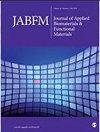HA-based dermal filler: downstream process comparison, impurity quantitation by validated HPLC-MS analysis, and in vivo residence time study
引用次数: 14
Abstract
The success of hyaluronic acid (HA)-based dermal fillers, with more than 2 million minimally invasive procedures conducted in 2016 in the US alone, is due to their hygroscopic properties of biocompatibility and reversibility. The type and density of HA cross-linkage, as well as the manufacturing technology, may influence not only the in vivo persistence but also the safety profile of dermal fillers. 1,4-Butanediol diglycidyl ether (BDDE) is the cross-linker used in most market-leading HA fillers; 1,4-butanediol di-(propan-2,3-diolyl) ether (BDPE) is the major impurity obtained from the HA–BDDE cross-linking (HBC) process. In this work, a new process to obtain high purity HBC fillers was developed. A new HPLC-MS method was validated for the quantification of BDPE content in HBC dermal fillers. In vitro cytotoxicity of BDPE was evaluated in fibroblasts (IC50 = 0.48 mg/mL). The viscoelasticity was monitored during the shelf-life of the HBC-10% hydrogel and was correlated with in vitro hyaluronidase resistance and in vivo residence time in a rabbit model. This analysis showed that elasticity is the best parameter to predict the in vivo residence time. Finally, a series of parameters were investigated in certain marketed dermal fillers and were compared with the results of the HBC-10% hydrogel.基于ha的真皮填充剂:下游工艺比较,通过有效的HPLC-MS分析进行杂质定量,以及体内停留时间研究
基于透明质酸(HA)的真皮填充物的成功,仅2016年在美国就进行了200多万次微创手术,这是由于它们具有生物相容性和可逆性的吸湿特性。HA交联的类型和密度,以及制造技术,不仅可能影响真皮填充物的体内持久性,还可能影响其安全性。1,4-丁二醇二缩水甘油醚(BDDE)是大多数市场领先的HA填料中使用的交联剂;1,4-丁二醇二(丙-2,3-二醇)醚(BDPE)是HA–BDDE交联(HBC)过程中获得的主要杂质。本工作开发了一种获得高纯度HBC填料的新工艺。验证了一种新的HPLC-MS方法用于HBC真皮填充物中BDPE含量的定量。在成纤维细胞中评估BDPE的体外细胞毒性(IC50=0.48mg/mL)。在HBC-10%水凝胶的保质期内监测粘弹性,并在兔模型中与体外透明质酸酶耐药性和体内停留时间相关。该分析表明,弹性是预测体内停留时间的最佳参数。最后,在某些市场上销售的真皮填充物中研究了一系列参数,并与HBC-10%水凝胶的结果进行了比较。
本文章由计算机程序翻译,如有差异,请以英文原文为准。
求助全文
约1分钟内获得全文
求助全文

 求助内容:
求助内容: 应助结果提醒方式:
应助结果提醒方式:


